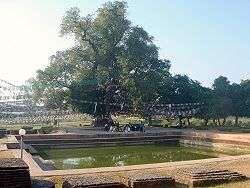List of World Heritage Sites in Nepal
The UNESCO (United Nations Educational, Scientific and Cultural Organization) has designated 4 World Heritage Sites in Nepal. The first sites from the Country Nepal were the Sagarmatha National Park and Kathmandu Valley.[1] In Nepal, there are 2 cultural and 2 natural mixed sites.[2]
The World Heritage Committee may also specify that a site is endangered, citing "conditions which threaten the very characteristics for which a property was inscribed on the World Heritage List." Two sites in this region are currently listed as endangered.[3]
Legend
The table is sortable by column by clicking on the ![]() at the top of the appropriate column; alphanumerically for the Site, Area, and Year columns; by state party for the Location column; and by criteria type for the Criteria column. Transborder sites sort at the bottom.
at the top of the appropriate column; alphanumerically for the Site, Area, and Year columns; by state party for the Location column; and by criteria type for the Criteria column. Transborder sites sort at the bottom.
- Site; named after the World Heritage Committee's official designation
- Location; at city, regional, or provincial level and geocoordinates
- Criteria; as defined by the World Heritage Committee
- Area; in hectares and acres. If available, the size of the buffer zone has been noted as well. A value of zero implies that no data has been published by UNESCO
- Year; during which the site was inscribed to the World Heritage List
- Description; brief information about the site, including reasons for qualifying as an endangered site, if applicable
Inscribed sites
| Site | Image | Location | Criteria | Area ha (acre) |
Year | Description | Refs |
|---|---|---|---|---|---|---|---|
| Chitwan National Park |  |
Chitwan District, Narayani Zone, 27°30′0″N 84°20′0″E / 27.50000°N 84.33333°E |
Natural: (vii), (ix), (x) |
93,200 (230,000) | 1984 | [4] | |
| Kathmandu Valley |  |
Kathmandu Valley, 27°42′14″N 85°18′31″E / 27.70389°N 85.30861°E |
Cultural: (iii), (iv), (vi) |
167 (410); buffer zone 70 (170) | 1979[nb 1] | The site has been listed as endangered 2003–2007 due to the partial or substantial loss of the traditional elements of six out of seven monument zones and resulting general loss of authenticity and integrity of the whole property. | [5] |
| Lumbini, the Birthplace of the Lord Buddha |  |
Rupandehi District, Lumbini Zone, 27°28′8″N 83°16′34″E / 27.46889°N 83.27611°E |
Cultural: (iii), (vi) |
1.95 (4.8); buffer zone 23 (57) | 1997 | [6] | |
| Sagarmatha National Park | |
Solukhumbu District, Sagarmatha Zone, 27°57′55″N 86°54′47″E / 27.96528°N 86.91306°E |
Natural: (vii) |
124,400 (307,000) | 1979 | [7] | |
Notes
- ↑ Minor modification of boundaries in 2006.
References
- General
- "World Heritage Committee: Twenty-fourth session" (PDF). UNESCO. Retrieved 26 June 2011.
- "World Heritage Committee: Twenty-seventh session" (PDF). UNESCO. Retrieved 26 June 2011.
- ↑ "Number of World Heritage properties inscribed each Year". UNESCO. Retrieved 8 September 2011.
- ↑ "Nepal - UNESCO World Heritage Centre". UNESCO. Retrieved 6 November 2016.
- ↑ "World Heritage in Danger". UNESCO. Retrieved 28 May 2010.
- ↑ "Chitwan National Park". UNESCO. Retrieved 28 May 2010.
- ↑ "Kathmandu Valley". UNESCO. Retrieved 28 May 2010.
- ↑ "Lumbini, the Birthplace of the Lord Buddha". UNESCO. Retrieved 28 May 2010.
- ↑ "Sagarmatha National Park". UNESCO. Retrieved 28 May 2010.